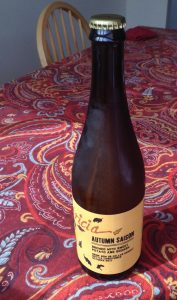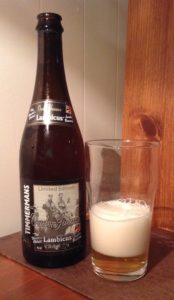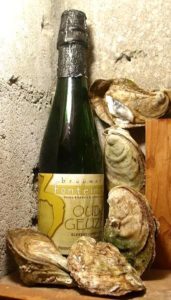I don’t know if this is a warning or tidings of good cheer. Boak and Bailey issued a short news post on Saturday because “not much has really grabbed our attention” and Stan followed suit. That’s reasonable given the time of year, folks out wandering and such, but I now feel somehow obligated to prove to you – to each of you – that beer blog news roundups matter.*
Speaking of Boak and Bailey, they were on the tartan trail and made it to Fort William in Scotland… or as we call it in the family For Twilliam. Dad’s Dad’s People were from there. Real kilty folk with McLeod at the end of each of their names. They hit all the pubs and probably hung out with a zillion of my third cousins. But we don’t talk with them. Something happened in the mid-1930s and, well, you know how that goes. The Campbell branch sorta blew up around 1908 and, well, we only started chatting again around 2009. Anyway, enough of me. What did they find?
The one everybody recommended was The Grog & Gruel. We didn’t have a good time on our visit between grumpy service, farting dogs and pass-agg encounters with Canadian tourists determined to nab our space. But it’s certainly a nice looking, pubby pub, and we can imagine having fun there under different circumstances.
Friggin’ Canadians. They ruin everything.
Speaking of travel, [T]he Beer Nut has finally** started to unpack his notes from the gang freebie flip to a beer fest in Wrocław, Poland. Now, don’t get me wrong, as I trust no one more that TBN when it comes to the little things like experience, wisdom and integrity but seeing as I lived in Poland I was interested to see what he thought about the place:
From three days of flitting randomly around the bars I did, however, get a certain sense of generic Craftonia about the offer. It seemed like everyone had the traditional styles — their pils, their weizen and their Baltic porter — and then a plethora of trend-chasers: New England IPA, fruited sour ales, barrel-aged imperial stouts, much of it indistinguishable or unremarkable from one brewer to the next. Next to none of them seemed to specialise in particular styles or processes. I did make an effort to pick unusual-looking beers when I saw them, so hopefully the reviews which follow won’t be too generic in turn.
Interesting. I liked the image of the large concrete hockey puck stadium as the setting for the event. Comforting that my Slavic former neighbours have not lost their dab hand with a spot of grey liquid stone. Martyn also reported on the event and associated opportunities and found “the selections of beers are almost entirely Polish” which I take to mean breweries rather than styles.
In another bit of flitting about, Eoghan Walsh has written about going “Into the Valley of the Lambic Lovers” for the latest issue of Ferment:
By the late 1990s, the lambic industry was emerging from a prolonged depression. Competition from industrial, sweetened lambic had nearly wiped out the traditional breweries of the region, leaving only revivalists like Frank Boon and Cantillon to keep it alive. By the 1980s, even they were questioning the sense in persevering with a beer that no one seemed to want to drink. But lambic people are stubborn people, they toughed it out and their perseverance began to pay off. Export interest slowly took off. Their gueuzes started winning awards. Then in 1991 the first edition of Michael Jackson’s Great Beers of Belgium was published.
What else? It can’t all be about hitting the road. Paste Magazine has an article on Hazy IPA which, after a couple of years of the stuff, is about as interesting as hard seltzer.*** Oddly, the article’s author seems to agree:
…the quest for “juicy” profiles in IPAs has led the beer industry in a direction that is actively undermining its own aims, and the result has become a whole lot of bad beer. Worse still, these poorly made NE-IPAs have proliferated to such an extent that they’re confusing the consumer as to what a “juicy” IPA is meant to taste like in the first place. We’re weaning a new generation of beer drinkers on a style that is often fundamentally difficult to drink, and that is a problem.
“Style” itself, of course, is to blame. The need to establish the new experiment in the same hierarchical construct as the loved and established. Find someone to proclaim that for you and, whammo, you are in the money. Fortunately, it’s all so transitory it is easily avoided. I am also one with Jeff on this and, as a bonus, give tribute his graph folk art skills.
 Speaking of the oddnesses of style, Stan caused a ripple in the continuum when he tweeted a photo of a (yik… spittoui!) pumpkin ale by a (whaaaaaat?!?!?!) Trappist brewery. Mucho replyo ensued. He used the moment to argue that “Trappist beer is an appellation, not a style” which is quite interesting because I am not sure what it means. It’s a bit like 1+0=0 mathematically but maybe it’s 1-0=1. You get my point. The other point is that the pumpkin as determined by God’s very own plan is last year’s old crop so I have no idea what the monks think they are up to.
Speaking of the oddnesses of style, Stan caused a ripple in the continuum when he tweeted a photo of a (yik… spittoui!) pumpkin ale by a (whaaaaaat?!?!?!) Trappist brewery. Mucho replyo ensued. He used the moment to argue that “Trappist beer is an appellation, not a style” which is quite interesting because I am not sure what it means. It’s a bit like 1+0=0 mathematically but maybe it’s 1-0=1. You get my point. The other point is that the pumpkin as determined by God’s very own plan is last year’s old crop so I have no idea what the monks think they are up to.
Katie has stayed at home, found a home for her tomatoes then celebrated in her very own living room. Speaking of which, it is reported that overall beer consumption in the UK is down by a third over the last twelve years:
“Premiumisation is impacting the Beer industry through drinkers drinking less but better,” the report says. Figures show that British people spent £177.8 million more on 66.5 million fewer pints of beer in 2017 than the year before, while the latest statistics from 2018 say that gap is widening, with a further £279 million being spent on another 40.6 million fewer pints. “On trade beer volumes have levelled out in recent years after a change in drinking habits, favouring drinking at home rather than in the pub,” said the report.
“Premiumisation”! What a silly word. ATJ added his thoughts on the story but they are behind a firewall so I don’t know what he wrote.
That is it for another week. I have the highest confidence that we can expect more beer news from Boak and Bailey on Saturday but Stan..? Stan is taking another hiatus as he will be “bouncing between cities in Brazil” which is something I would like to see. Bouncing?!? I may need to approach the travel authorities about this. We’ll see how much bouncing is going on then! Until then, bye!
*Maybe.
**Finally!
***Or “American creamy milk” for that matter.















